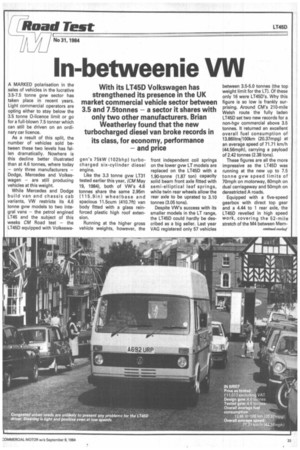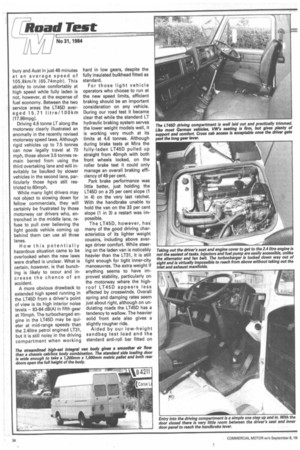In-betweenie VW
Page 35

Page 36

Page 37

If you've noticed an error in this article please click here to report it so we can fix it.
With its LT45D Volkswagen has strengthened its presence in the UK market commercial vehicle sector between 3.5 and 7.5tonnes — a sector it shares with only two other manufacturers. Brian Weatherley found that the new turbocharged diesel van broke records in its class, for economy, performance — and price
A MARKED polarisation in the sales of vehicles in the lucrative 3.5-7.5 tonne gvw sector has taken place in recent years. Light commercial operators are opting either to stay below the 3.5 tonne 0-licence limit or go for a full-blown 7.5 tonner which can still be driven on an ordinary car licence.
As a result of this split, the number of vehicles sold between these two levels has fallen dramatically. Nowhere is this decline better illustrated than at 4.6 tonnes, where today — only three manufacturers — Dodge, Mercedes and Volkeswagen — are still producing vehicles at this weight.
While Mercedes and Dodge build van and chassis cab variants, VW restricts its 4.6 tonne gvw models to two integral vans — the petrol engined LT45 and the subject of this weeks CM Road test — the LT45D equipped with Voikeswa
gen's 75kW (102bhp) turbocharged six-cylinder diesel engine.
Like the 3.3 tonne gvw LT31 tested earlier this year, (CM May 19, 1984), both of VVV's 4.6 tonnes share the same 2.95m (1 1 5.9in) wheelbase and spacious 11.5cum (410.7ft) van body fitted with a glass reinforced plastic high roof extension.
Running at the higher gross vehicle weights, however, the front independent coil springs on the lower gvw LT models are replaced on the LT45D with a 1.90-tonne (1.87 ton) capacity solid beam front axle fitted with semi-elliptical leaf springs, while twin rear wheels allow the rear axle to be uprated to 3.10 tonnes (3.05 tons).
Despite VVV's success with its smaller models in the LT range, the LT45D could hardly be described as a big seller. Last year VAG registered only 57 vehicles between 3.5-5.0 tonnes (the top weight limit for the LT). Of these only 16 were LT45D's. Why this figure is so low is frankly surprising. Around CM's 210-mile Welsh route the fully laden LT45D set two new records for a non-hgv commercial above 3.5 tonnes. It returned an excellent overall fuel consumption of 13.861itre/100km (20.37mpg) at an average speed of 71.71 km/h (44.56mph), carrying a payload of 2.42 tonnes (2.38 tons).
These figures are all the more impressive as the LT45D was running at the new up to 7.5 tonne gvw speed limits of 70mph on motorway, 60mph on dual carriageway and 50mph on derestricted A roads.
Equipped with a five-speed gearbox with direct top gear and a 4.44 to 1 rear axle, the LT45D revelled in high speed work, covering the 52-mile stretch of the M4 between Mem bury and Austin just 48 minutes at an average speed of 105.8km/h (65.74mph). This ability to cruise comfortably at high speed while fully laden is not, however, at the expense of fuel economy. Between the two service areas the LT45D averaged 15.71 litre/100km (17.98mpg).
Driving 4.6 tonne LT along the motorway clearly illustrated an anomally in the recently revised motorway speed laws. Although rigid vehicles up to 7.5 tonnes can now legally travel at 70 mph, those above 3.5 tonnes remain barred from using the third overtaking lane and will inevitably be baulked by slower vehicles in the second lane, particularly those hgvs still restricted to 60mph.
While many light drivers may not object to slowing down for fellow commercials, they will certainly be frustrated by those motorway car drivers who, entrenched in the middle lane, refuse to pull over believing the light goods vehicle coming up behind them can use all three lanes.
How this potentially hazardous situation came to be overlooked when the new laws were drafted is unclear. What is certain, however, is that bunching is likely to occur and increase the chance of an accident.
A more obvious drawback to extended high speed running in the LT45D from a driver's point of view is its high interior noise levels — 83-84 dB(A) in fifth gear at 70mph. The turbocharged engine in the LT45D may be quieter at mid-range speeds than the 2.4Iitre petrol engined LT31, but it is still noisy in the driving compartment when working hard in low gears, despite the fully insulated bulkhead fitted as standard.
For those light vehicle operators who choose to run at the new speed limits, efficient braking should be an important consideration on any vehicle. During our road test it became clear that while the standard LT hydraulic braking system serves the lower weight models well, it is working very much at its limits at 4.6 tonnes. Although during brake tests at Mira the fully-laden LT45D pulled up straight from 40mph with both front wheels locked, on the roller brake test it could only manage an overall braking efficiency of 49 per cent.
Park brake performance was little better, just holding the LT45D on a 25 per cent slope (1 in 4) on the very last ratchet. With the handbrake unable to hold the van on the 33 per cent slope (1 in 3) a restart was impossible.
The LT45D, however, has' many of the good driving characteristics of its lighter weight cousins, including above average driver comfort. While steering on the laden van is naticably heavier than the LT31, it is still light enough for tight inner-city manoeuvres. The extra weight if anything seems to have improved stability, particularly on the motorway where the highroof LT45D appears less affected by crosswinds. Overall spring and damping rates seem just about right, although on undulating roads the LT45D has a tendency to wallow. The heavier solid front axle also gives a slightly rougher ride.
Aided by our low-height sandbag test load and the standard anti-roll bar fitted on the rear axle, the VW van exhibited very little body roll even around the twisty country road section of our test route.
Early morning starts with the LT45D seemed to produce an inordinate amount of white smoke which took a good five to 10 minutes to subside. A telephone call to VAG at Milton Keynes revealed that following a previous complaint our test vehicle had been fitted with a new set of injectors and been passed fit for duty.
In fairness to VW, the problem became less obvious towards the end of our test period, although throughout its two weeks with CM, the LT45D produced a noticeable amount of black smoke, particularly when accelerating, which soon covered the rear side rear wheels.
Instrumentation on the LT45D is simple and straight-forward, only differing from LT31 by the addition of the neat flush mounted tachograph and cold start aid on the right of the 450mm (17.73in) diameter steering wheel. The five-speed gearbox has a well defined shift pattern spoilt only by the change from 1st to 2nd which is awkward if rushed. Unladen the LT45D pulls away easily enough in second making first unnecessary.
Visibility on the 4.6 tonne VW is good, aided by the deep starting A posts, while the firmly fixed mirrors are positioned well behind the quarterlight upright giving plenty of rear vision.
Summary For those haulage fleets or distribution companies looking for a quick non-hgv feeder topup vehicle without the maximum carrying capacity of a 7.5 tonner, the LT45D must surely rate high among any buyers list. Carrying an above average payload of 2.42 tonnes, VW's turbocharged integral van not only covers long distances rapidly and extremely economically, but also has the interior comfort and handling characteristics likely to appeal to any delivery driver.
For all this, however, Volkswagen charges an excessively high price premium of £11,013 excluding vat, compared to its nearest rival the Dodge S46 at £10,440 and the L407D Mercedes, which is cheaper still at £9,540. Indeed, at a time when the 4.6 tonne market is already shrinking, VW's LT45D pricing policy is unlikely to reverse this trend suddenly.




























































































